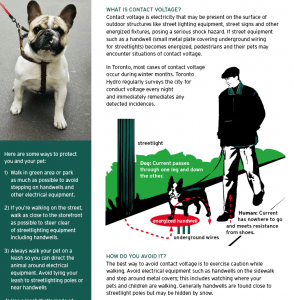By now, you have probably heard the sad story out of Outremont last week – about the dog electrocuted by a faulty lightpost. Although statistically rare (which we recognize is no consolation to those affected), it is a devastating way to lose a pet – and a situation which has occurred in the past: It happened in Toronto last year, in Seattle the year

before and also New York City. Other incidents are cited in this Gazette article. Here at Montreal Dog Blog, our hearts go out to Lily’s foster family. And hope this piece can serve to help pet owners in the future.
We first heard of this incident from a person who’s dog, Sophie, was electrocuted (but survived) just minutes before Lily. The letter we received from Francesca Theriault (condensed for print) is below:
On Tuesday night (Jan. 17th), our dog Sophie was electrocuted, simply walking on the sidewalk – by current from a city streetlight. She survived, due to a quick reaction by Jeff. Seeing her falling very suddenly to the

ground, writhing in pain, convulsing and biting furiously at her hindquarters all the while emitting the most horrendous screeches and howls, Jeff picked her up in his arms. This had the effect, we later deduced, of cutting the current going into Sophie. Since Jeff was wearing boots and gloves, he himself was not harmed. Sophie was lucky (EDITOR’S NOTE: PLEASE SEE VETERINARY NOTE AND TORONTO HYDRO TIPSHEET BELOW). Another dog, a cute 5 year old lab-terrier mix, named Lily, was not so lucky. Just 15 minutes after Sophie’s experience, we heard a dog howling in exactly the same way and rushed out to try and help. Unfortunately, Lily did not survive the electrocution. It was an absolutely horrible death, and Lily’s owner is in shock and inconsolable.
How does this happen? Metal street lamps/light posts are either not at all or poorly insulated and often not grounded. Stray current travels to the adjoining sidewalk area. In the winter when there are several periods of freezing and melting and when the sidewalks are covered in salt, the salt water is an efficient conducting material for this stray current. The City of Montreal electricians who responded to the incident confirmed this. Humans are most often unaffected because of our rubber-soled winter boots or shoes and also from the fact that when we are walking we only have one foot on the ground at a time (some people however, have felt shocks when touching or leaning against one of these metal posts). But our four-legged friends are not insulated – their moist pads combined with the salt water make them extremely vulnerable to the current and their size means that even a small amount of current can cause injury or death. Wearing non-rubber dog booties against the salt and pebbles strewn on our streets and sidewalks can actually aggravate the situation, since they provide an extra layer of moisture. Further, allowing a dog to pee against the metal post or in proximity of the post provides extra minerals to conduct the current. Again the result can be deadly. Though there is no salt on the sidewalks in the summer such electrocutions have occurred during or after heavy downpours in the non-winter months.
What to do? Though we cannot really predict where these incidents could occur, there are some things that can help prevent serious injury:
- When the ground is wet and/or icy and/or covered in salt, avoid walking near any metal object that may be in contact with electricity. This includes manholes, grates and metal plates, street lamps and fire hydrants.
- Don’t allow your dog to sniff or pee against or near metal light posts.
- Don’t let your dog walk on or pee on metal grates or plates on the street or sidewalk. If you do have your dog wear booties, get rubber booties and make sure that they are water-tight (no water pooling inside of them and no holes).
- Don’t use metal collars and/or leashes and if possible use collars and leashes that contain a minimum of metal detailing.
- If you notice street lamps flickering on/off (a possible sign of a short circuit) or if street lamps are not working, advise your municipality or city immediately and do not walk your dog near these posts.
Please pass this message on to the maximum number of pet owners. I want to say once again how awful I feel for Lily and her owner, and how I truly sympathize with her shock and grief.
-Francesa Theriault
NOTE: Montreal Dog Blog contacted Outremont Councillor Marie Potvin to ask why the lights were not being inspected sooner than the Spring. Here is her reply: En réponse à votre question, en raison de la saison hivernale ( gel au sol) et de l’appel d’offres que nous devons préparer afin de procéder à l’évaluation de nos lampadaires, ce travail ne pourra se faire avant quelques semaines pour ces raisons uniquement. Cependant le lampadaire qui a causé ce malheureux accident a été sécurisé et vérifié encore cette semaine.
TORONTO HYDRO FACT SHEET ON AVOIDING PET ELECTROCUTION:

Here is an excellent tipsheet, released by Hydro Toronto: hydropetsheet. Please download it and review it’s contents. It could save not only your dog’s life – but can ensure the wellbeing of your human friends and neighbours as well!
IF YOUR DOG IS EXPERIENCING AN ELECTRIC SHOCK (taken from the above tipsheet):
If you come across an instance of contact voltage, your pet may freeze and collapse. Animals have reportedly suffered from seizures and muscle contractions. In severe cases, some animals experience respiratory distress or failure. Before you act, assess the situation for existing hazards. It may be your first instinct to grab a person or pet in distress, but this may pass the electric current to you, rendering you both incapable of seeking help. It is important to move a safe distance away from areas of contact voltage. Ensure pedestrians stay clear of the area. Most recipients of electric shock caused by contact voltage are pets.
If your pet is incapacitated, do not touch the animal directly as you may also receive an electric shock. If you have a dry and non-conductive leash, remove your pet from the hazard by pulling the leash or use another non-conductive object.
A NOTE FROM MONTREAL VETERINARIAN and DOG BLOGGER, CHRISTINA NOSOTTI:
 Montreal Dog Blog Montreal's Online Dog Park
Montreal Dog Blog Montreal's Online Dog Park



